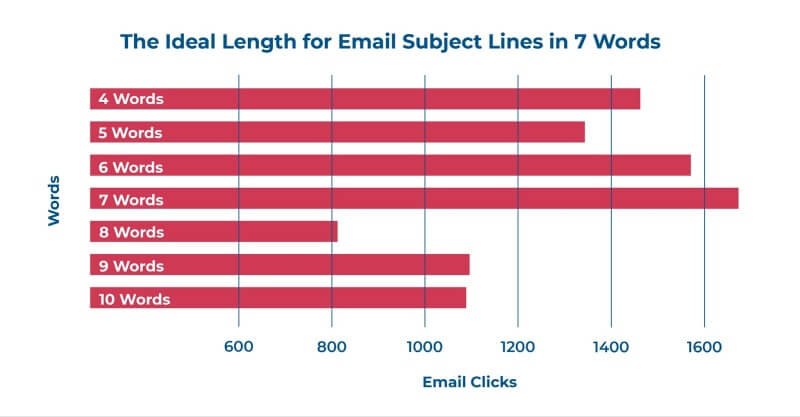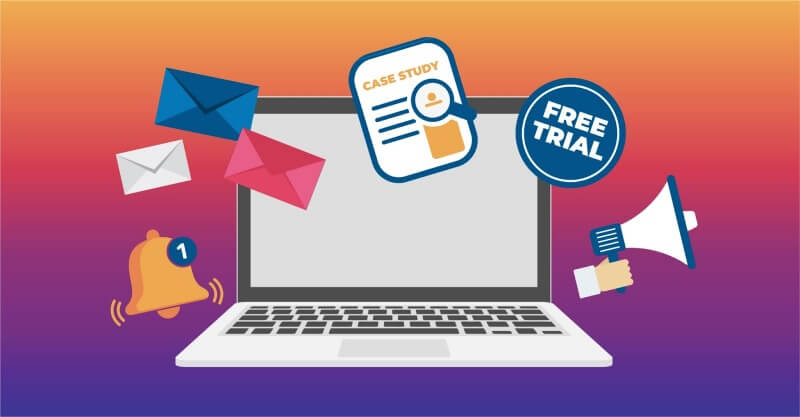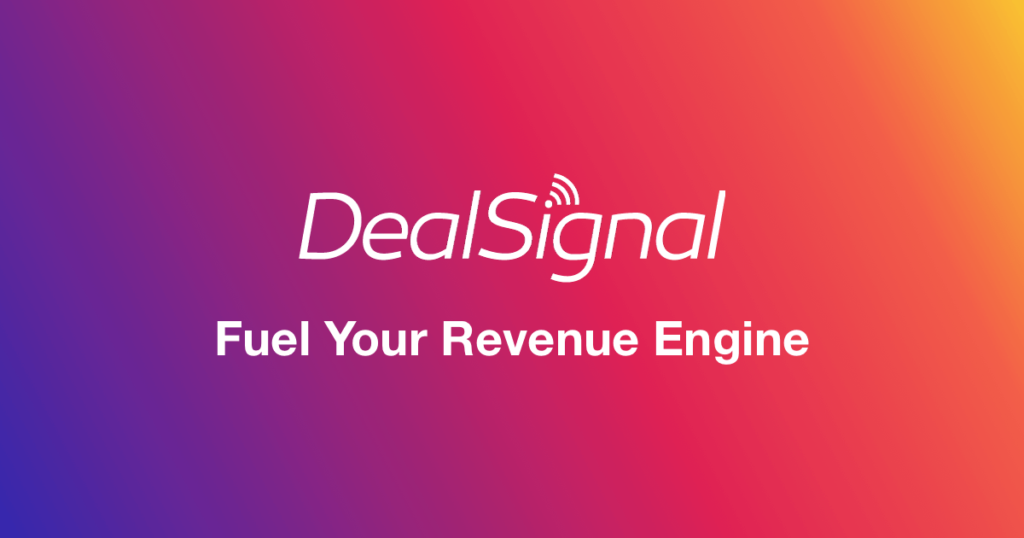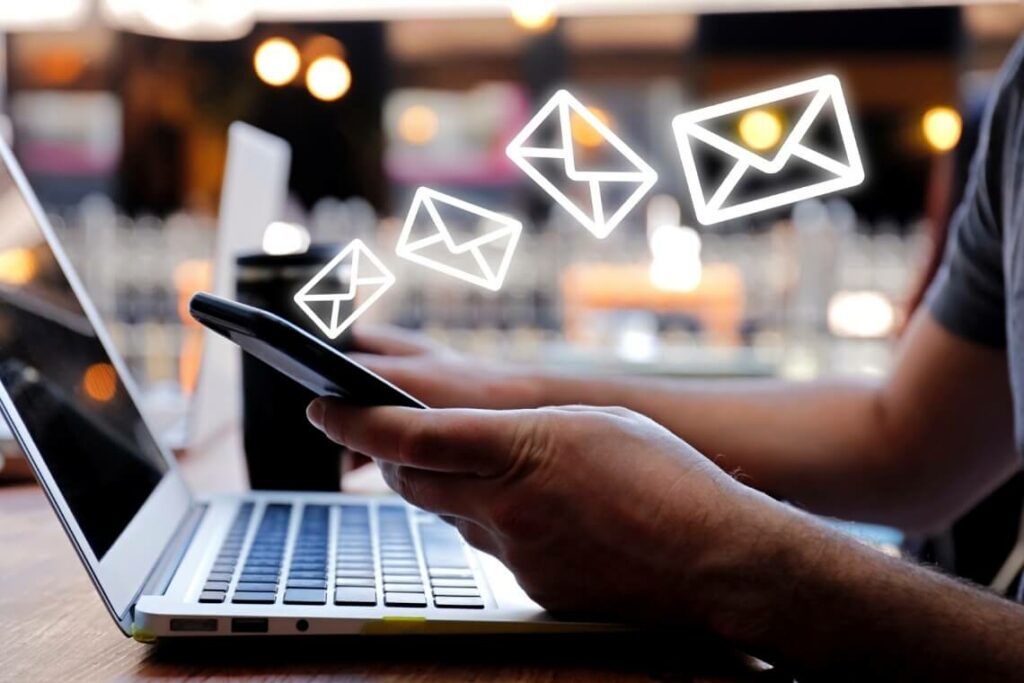According to HubSpot, 77% of marketers saw an increase in email engagement over the last 12 months, and marketers who used segmented campaigns saw as much as a 760% increase in revenue.
The numbers don’t lie. When done correctly, email marketing is a low-cost, high-return tactic that should be weaved into any content marketing strategy.
- What Is B2B Email Marketing?
- B2B Email Marketing Benchmarks
- Improving Email Deliverability
- B2B Email Marketing Best Practices
- Write enticing subject lines
- Avoid clickbait
- Think about the sender’s name
- Keep the message clear and concise
- Personalize whenever possible
- Create a variety of content
- Don’t be promotional—be a thought leader and add value
- Highlight social proof
- Don’t go overboard with CTAs
- Consider using plain text
- Use graphics to tell a story
- Test, test, and test again
- Track Results
- B2B Email Marketing Examples
- The Obstacles B2B Marketers Are Facing
- Invest in the Right B2B Email Marketing Tools to Reach Your Ideal Buyers
- Learn more about Email Marketing
What Is B2B Email Marketing?
B2B email marketing is when a business sends emails to other targeted business professionals to generate leads, build client relationships, schedule demos, and/or schedule sales calls. Essentially, these B2B emails should have a clear, easy-to-spot call to action to help move prospects further down the buyer’s journey.
B2B email marketing is not blasting promotional material to a large number of recipients, hoping that someone responds or becomes a lead. Often, it involves thought leadership content that is tailored to its target audience. This differs from B2C email marketing, where email campaigns are directed to individual consumers and tend to be more promotional in nature.
Email Marketing for B2B Lead Generation
Two major goals among many B2B email marketers are:
1) building out your database of marketing-qualified leads and
2) generating high-quality leads for their sales team.
At the end of the day, marketers and sales professionals are rewarded and recognized for helping generate more revenue for their companies. B2B email marketing is a great, cost-efficient way to reach prospects and convert contacts into actual leads.
According to multiple surveys and reports, B2B marketers tend to use email marketing primarily for lead generation and lead nurturing, while other departments within the organization use email marketing for sales and customer retention.

- When rating the top goals for B2B email marketing on a scale from 1-5, lead generation came at the top (85%), followed by sales (84%), lead nurturing (78%), and customer retention (74%).
- 59% of B2B marketers prefer email for lead generation.
- 45% of marketers consider email marketing to be one of the most effective lead-generation tactics.
B2B Email Marketing Benchmarks
Before we jump into best practices and examples, it’s important to cover the common benchmarks used to measure success in email marketing.
- Deliverability Rate: This figure tells you how many emails in your campaign successfully arrived in the recipient’s inbox. The deliverability rate is calculated by taking the number of delivered emails and dividing it by the total number of emails sent. This benchmark is critical. What good is an email campaign if no one actually sees it because it didn’t get successfully delivered to the recipient’s inbox?
- Open Rate: The percentage of email recipients who opened an email. If you’re trying to understand what an average open rate to aim for is, you’ll find that it varies depending on the industry and on whether the email list you are sending to is a cold audience, a list of qualified leads, or a current customer list.
- Click-Through Rate: This is the percentage of recipients who clicked on a link or image in your email.
- Bounce Rate: A bounced email is one that couldn’t be delivered, which could be related to server or spam issues. This percentage represents the number of recipients who didn’t receive your message. There are hard bounces and soft bounces, which are both calculated into your overall bounce rate.
A hard bounce means an email couldn’t be delivered for permanent reasons like the email address no longer exists or the recipient’s email server has completely blocked the delivery of emails from your domain. A soft bounce indicates a temporary issue like the user’s mailbox being too full or their server being temporarily down. - Unsubscribe Rate: This is the percentage of people who unsubscribe or opt out of receiving any further emails.
- Generated Leads: Email leads are generally leads whose contact information you’ve collected through a product demo request form, content asset download form, contact us form, and/or newsletter opt-in form. Depending on how you configure the scoring within your marketing automation platform, these leads could be either unqualified leads, marketing-qualified leads, or simply contacts.
Improving Email Deliverability
Out of all the email marketing benchmarks, deliverability is one of the most critical figures. After all, if your deliverability is poor, that negatively impacts all other benchmarks. Poor email deliverability typically stems from a bad sender reputation, spam complaints, and/or high bounce rates. And once you’ve been dinged, it can be difficult to climb back up. Here are some best practices you should follow to improve and maintain good email deliverability.
- Be consistent with your sending volume. If you send very few emails and then all of a sudden pump out multiple emails a day, this change in behavior could flag your email domain and negatively impact your deliverability rate. Try to keep a consistent, regular schedule. If you anticipate a need to increase your volume, try to gradually increase your sending volume instead of making sudden, drastic changes.
- Send emails in batches. Sending emails to extremely large lists of recipients may increase your chances of being flagged as spam. Instead of sending emails all at once to large lists, it’s recommended to send small batches at regular intervals.
- Authenticate your domain. This is especially important if you do not have any domain history or are new to the field. Authentication involves linking your domain to the IP address, and your ISP will be displayed on the recipient’s end. This ensures your credibility as a sender and indicates that your emails are coming from a trusted source. Most email service providers (ESP) will authenticate your domain with Sender Policy Framework (SPF) or DomainKeys Identified Mail (DKIM).
- Keep your contact list clean. If your email lists are riddled with outdated email addresses, that could drive your bounce rate and negatively impact deliverability. If you’re buying email lists or B2B contact data from a third-party vendor, be cautious and ask your vendor how they verify their data. If you’re unsure of what you should be asking to ensure that you’re getting accurate data, you can check out our Checklist of Questions to Ask B2B Data Vendors.
- Provide options to subscribers. You should always provide an option for email recipients to unsubscribe from your emails. The unsubscribe link or button should also be clearly visible, accessible, and in bold. Make it as easy as possible for the recipients to unsubscribe. If you make it difficult for users to unsubscribe or update their email preferences, you may get lots of user complaints and spam reports—both detrimental to your domain reputation and deliverability.

B2B Email Marketing Best Practices
81% of B2B marketers use email marketing in their content strategy. With the constant barrage of emails arriving in your ideal buyers’ inboxes, it’s critical to create and send effective emails that stand out from the crowd. Keep these best practices in mind for your next email marketing campaign.
Write enticing subject lines
There are two reasons someone opens an email: it’s from someone that they know or the subject line catches their attention. Crafting a well-written, enticing subject line is key to achieving higher open rates.
Writing a great subject line is harder than it seems since you have limited real estate to work with. According to a study by Marketo, 41 characters or 7 words is the ideal email subject line length for optimal open rates. Shorter is better because you never know how much your subject line will be truncated, and it’s mobile-friendly. Different devices and email clients will truncate email subject lines differently. So, for example, if someone accesses their email on a mobile phone, they will probably see a more truncated version of a given subject line than on their desktop computer.

Avoid clickbait
At the same time, avoid writing subject lines that can come across as clickbait. Nobody likes the old bait and switch. If a prospect or lead feels fooled, that only damages your relationship and their perception of your brand.
There are also many spam triggers you should avoid in subject lines. Using all-caps text or extreme punctuation, like multiple exclamation marks, can flag your email as spam. There are also many spam trigger words that, if used frequently, can begin marking your emails as spam and damage your email deliverability. Spam trigger words are words or phrases that over-sensationalize, like:
- FREE
- F r e e
- For just $XX
- 100% satisfied
- Act now! One time only
- #1
- Join millions of
In some cases, it may be appropriate to use certain words that could be classified as spam trigger words. The key is to use them sparingly and only when it truly makes sense.
Think about the sender’s name
Remember, the second reason why a person opens an email is because of the sender. Are they familiar with the person or the company? If so, they are more likely to open the email. In the “from” field, you may want to consider using your first name along with the company name, like “Jake from Statefarm.” That way, the recipient has two reference points of familiarity: the person and the brand.
Keep the message clear and concise
Nobody has time to read long emails. Period. Even if you have a compelling story, reading paragraphs of text will almost always feel like a chore for the recipient. If you assign “work” to your prospects or leads, they’re more likely to simply move on and delete your email before they reach the enticing offer or value-add you’re trying to provide. Get to the point quickly, keep the message short, and make sure that your message can be clearly understood. You don’t want to leave any room for confusion.
Personalize whenever possible
Try personalizing emails with the recipient’s first name in the subject line or email content. Simple personalization efforts like this can go a long way in capturing a person’s attention.

Create a variety of content
If your recipient associates you solely with sales pitches or promotional emails, that may hinder the relationship from progressing. In addition to these types of emails, you should also create email campaigns that aim to engage, educate, share value, and provide important updates. Create emails that share announcements, case studies, free trial offers, webinar invitations, and more.
Don’t be promotional—be a thought leader and add value
With B2B email marketing, you should focus on creating emails that read as a one-on-one conversation or as authoritative thought leadership. People want to do business with those who care, not companies who are just in it for a quick sale.
Highlight social proof
Let your customers do the talking for you—they’re your greatest advocate, after all. Case studies, success stories, testimonials, and public reviews all go a long way in building a recipient’s trust for your brand.
Don’t go overboard with CTAs
When you confuse, you lose. Aim for 1-2 CTAs in your emails—anything beyond that and the reader may become unclear on what they should do next.
Consider using plain text
Eye-catching imagery is great for B2C email marketing, but plain text tends to be favored by B2B marketers for a number of reasons. For one, plain text emails load much faster than those with images.
Plain text emails are also supported by all email clients, so you can be certain that there’s consistency in delivery and accessibility across the board. The plain text format also lends itself well to conversational emails that feel more personal. Of course, this doesn’t mean that you should never send HTML emails in a B2B campaign—but it’s a good idea to test both to see what works for you.
Use graphics to tell a story
The era of relying solely on plain text emails to engage clients and partners is fading. With individuals bombarded by a constant stream of work-related correspondence daily, the challenge of capturing attention has never been more pressing. To stand out amidst the noise, businesses are urged to embrace the power of visual storytelling. Whether through captivating graphics or informative infographics, conveying narratives in visually compelling formats has become a cornerstone of effective email marketing strategies. For those businesses yet to explore the realm of graphic design in their email campaigns, the time to act is now. In an environment where competition intensifies by the minute, infusing creativity into email communications isn’t just a trend—it’s a necessity for success in the dynamic landscape of 2024.
Test, test, and test again
This tip is twofold. First, you need to test emails before they go out. Are all links working properly? Does the formatting appear correctly on desktop, tablet, and mobile? You’ve spent all this time creating a great email, so you should make sure all of that hard work is reflected properly on the end deliverable.
Next, don’t forget about A/B testing. You can A/B test subject lines—length, style, use of emojis, etc.— to analyze what encourages a higher open rate. Or, you can A/B test the email’s body content for factors like style, voice, formatting, CTAs, and more. Use each email as a chance to learn how you can improve future campaigns.
Here is a sample list of questions that should be answered before sending the send button:
- What is the defined maximum number of contacts per company?
- Are competitors suppressed?
- Are previous lists suppressed?
- Is the unsubscribe link clearly visible and in bold?
- Are all Email addresses scrubbed and verified? (Results should not exceed a 3% bounce rate.)
- Has a test email been sent and approved?
- Have you double-checked for misspellings, grammar, and formatting?
- Have you tested every single link?
- Have you sent a pilot sample for A/B testing of the subject line?
- Have you picked the A/B test winner?
Track Results
There is an ongoing process that involves tracking the performance of your campaigns, analyzing what contributed to successes and failures, and continually optimizing your strategies based on insights gained.
It’s essential to recognize that what works well now may not be as effective in the future. Thus, it’s crucial to track results over time to adapt to changing trends and preferences.
To track results effectively, consider the following tips:
- Focus on objectives: Success will vary for each business, so concentrate on what you want to achieve rather than comparing it to industry standards or competitors. Set specific, measurable, attainable, realistic, and timely (SMART) goals for each campaign to gauge its success accurately.
- Measure relevant metrics: Align the metrics you track with your campaign objectives. For example, if your goal is to increase social media followers, monitor the number of visitors to your social media profiles. If the objective is to generate demos, measure the number of signups per campaign.
- Analyze engagement metrics: Pay attention to key engagement metrics like open rates, click-through rates, and conversion rates. These metrics provide insights into how well your emails resonate with your audience and drive action.
- Monitor conversion rates: Analyze the conversion rate from email subscribers to actual customers or leads. Understanding conversion rates helps you identify successful campaigns and refine strategies that lead to higher conversions.
- Ensure list health: Keep track of your email list health by monitoring metrics like bounce rates and unsubscribe rates. A healthy list ensures better deliverability and engagement.
- Use A/B testing: Conduct A/B testing on different elements of your emails, such as subject lines, content, and CTAs. This approach allows you to identify the most effective variations and make data-driven decisions for future campaigns.
- Track trends over time: Analyze performance trends and patterns over time. This ongoing analysis helps you stay agile and adapt your B2B email marketing strategies to evolving market conditions.
By continually tracking results and focusing on your unique business objectives, you can optimize your B2B email marketing efforts and achieve more successful outcomes over time.
B2B Email Marketing Examples
If you want to take a peek at what other marketers are sending out to get inspiration for your next email campaign, try using Milled or Good Sales Emails.
Milled is a search engine for email newsletters. Search for a brand and you can view all the most recent emails that the brand has sent out to their customers. Although this website primarily has emails from B2C brands—like Nike, Sephora, and Birchbox—you may be able to find a brand in a similar category as your business and stumble across great subject line ideas.
Good Sales Emails aggregates real sales emails sent by hundreds of B2B companies, like Mixpanel, Gusto, Zoom, HubSpot, and more. This is a great resource for finding real-world examples of B2B emails, and even emails that fall directly within your industry or niche.
The Obstacles B2B Marketers Are Facing
A big issue that many B2B marketers face when it comes to creating successful email campaigns is a lack of quality contacts to send their campaigns to. It’s all too common to have great email content lined up but a smaller-than-desired audience to direct those campaigns to.
Lack of accuracy from third-party vendors
To solve this issue, email marketers have looked towards third-party vendors that sell B2B contact lists. But, this solution only leads to more problems. Lists provided by data vendors are usually riddled with outdated, inaccurate email addresses, and by sending email campaigns to so many bad email addresses, you risk a high bounce rate. If you consistently send emails with a high bounce rate, you can get your company’s email domain flagged as spam.
Too many missed opportunities
Maintaining a clean email list is critical for deliverability, so many marketers rely on email validation software to help them clean up their lists.
Although email validation software can help remove bad email addresses from your lists, you also risk losing a significant percentage of perfectly good emails. Most email validation systems aren’t built with an advanced level of sophistication, so it’s very likely that the software will be unsure about a large number of email addresses.
In our experiment using an email validation software vendor, the vendor was uncertain about the validity of 35.9% of the email addresses on our list and made an aggressive recommendation to eliminate 53% of our contacts. That is a significant amount—and remember, that 35.9% figure could include perfectly good emails. That’s a lot of potentially missed opportunities.
Not reaching the right audience
Another problem with most third-party data vendors is that even if the accuracy of the contact data provided is decent, vendors most likely don’t have the resources to generate a highly-targeted list that matches your campaign’s needs. For example, perhaps you need to send an email to people who have a specific role in their company, such as Graphic Design. Most third-party data vendors won’t be able to get as granular and may instead provide you with contacts who are categorized under a general “Marketing and Advertising” function. This can include Media Buyers, PPC specialists, or Technical SEOs—all roles that wouldn’t hit the mark for your campaign’s needs.
Modern B2B databases aren’t providing results
Once modern B2B databases rolled out, where users can pay a subscription fee for access to millions of B2B contacts, it seemed like the answer to many of these problems. But once again, the data accuracy has proven to be very poor across the board. It’s also difficult to find contact data on your ideal buyers, since there are only so many contacts that a generalized database can provide.
Invest in the Right B2B Email Marketing Tools to Reach Your Ideal Buyers
Generating contact lists with third-party databases and using email validation software to clean it up may help—but the results will be negligible. If you’re pouring hundreds or thousands of dollars into these tools but not seeing results, something’s wrong.
With DealSignal, you get access to a suite of solutions that combine advanced data verification techniques with Artificial Intelligence and Machine Learning to provide you with contact data at 97%+ accuracy. For B2B email marketing campaigns, you can use:
- Contact Discovery to build a list of the most relevant key decision-makers.
- Intent-Based Leads to find buyers who are in the market for your solution right now.
- Inbound Lead Enrichment to get fresh, verified, and accurate data on your current contact list.
To see the DealSignal solution in action and learn how it can help increase your B2B email marketing campaigns’ performance, schedule a free demo here.

Dynamic B2B Data On-Demand. Transparent Pricing. Market-Leading Customer Support.
Learn more about Email Marketing
- How B2B Data Quality Impacts Email Deliverability
- Don’t Let Email Validation Software Throw the Baby Out with Bathwater
- How To Improve Email Deliverability
- From Cold to Sold: 10 Powerful Email Marketing B2B Lead Generation Strategies
- Email Engagement Strategy: Accomplish Superior Email Deliverability




